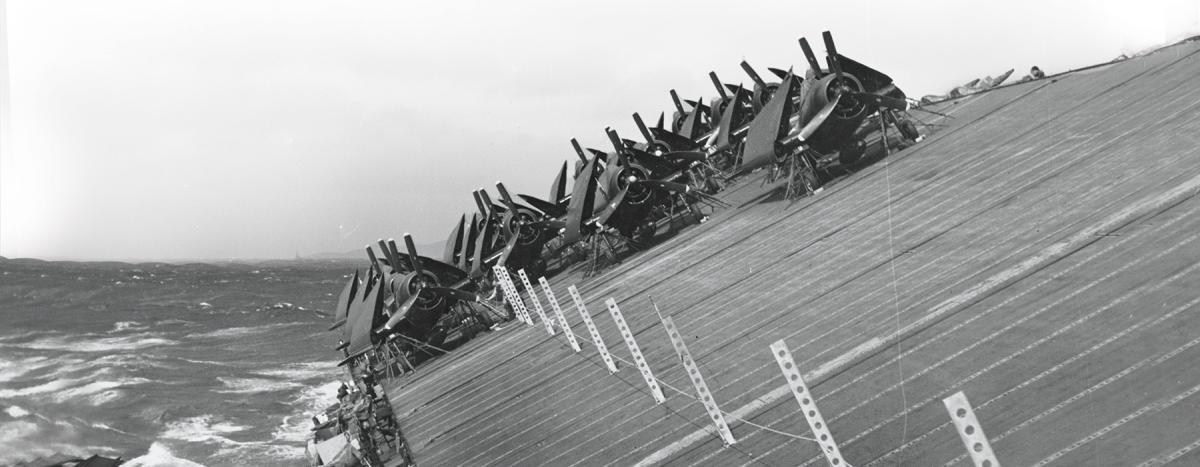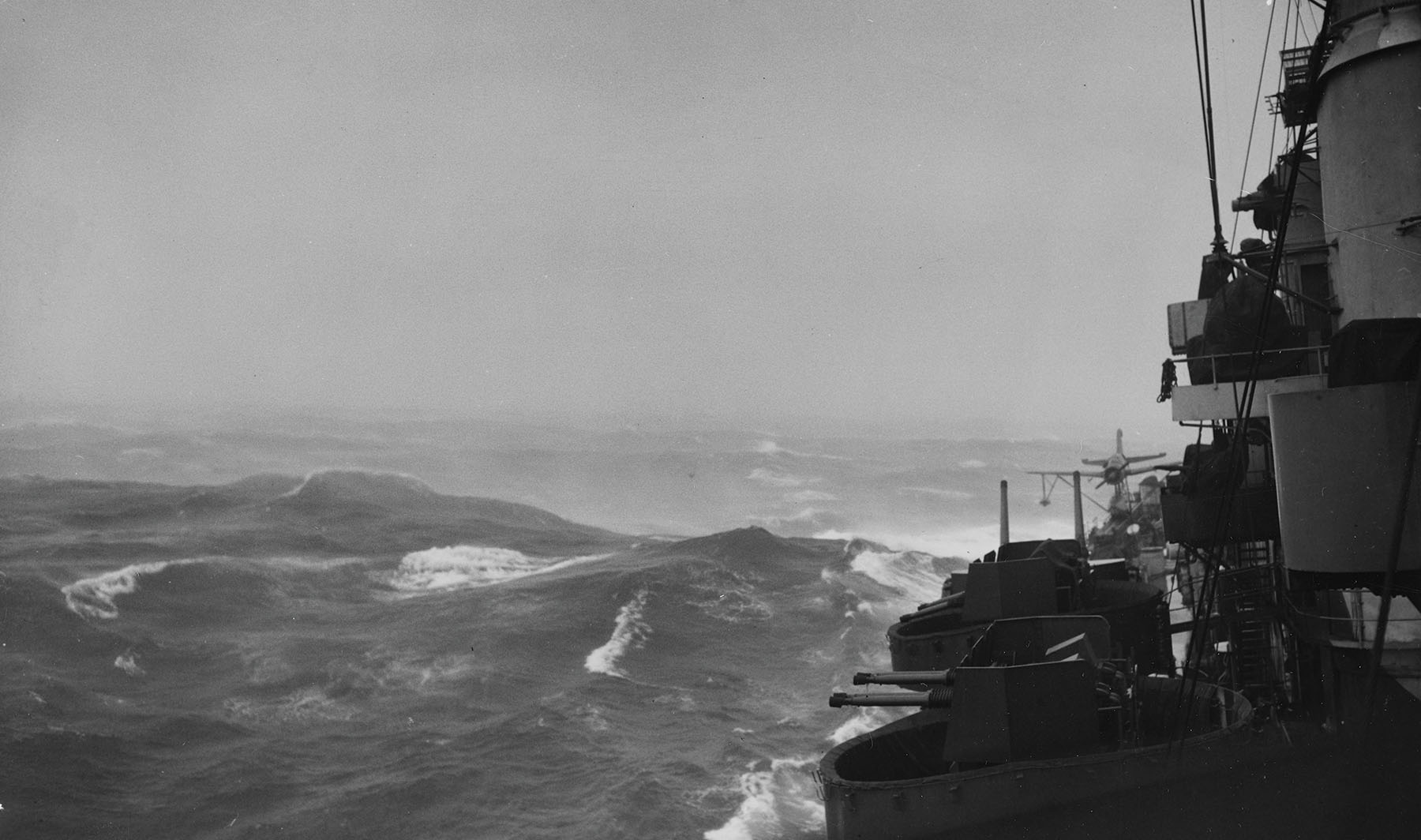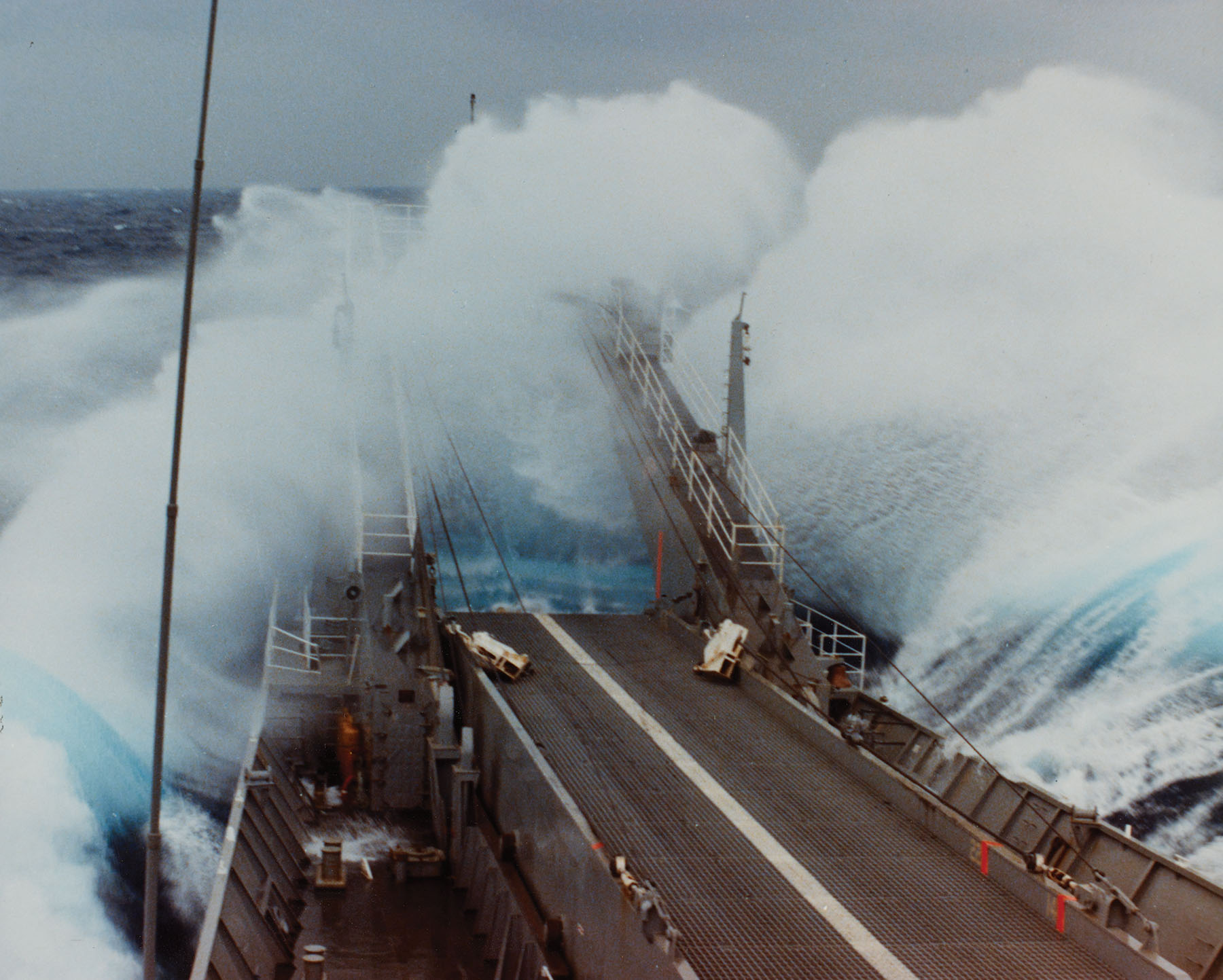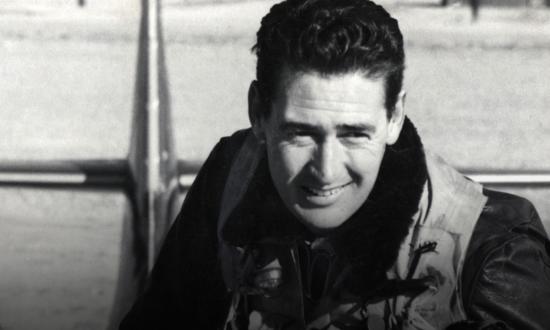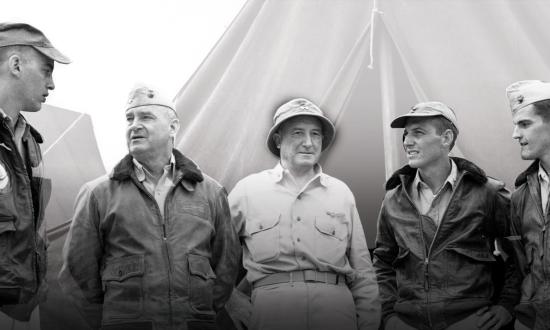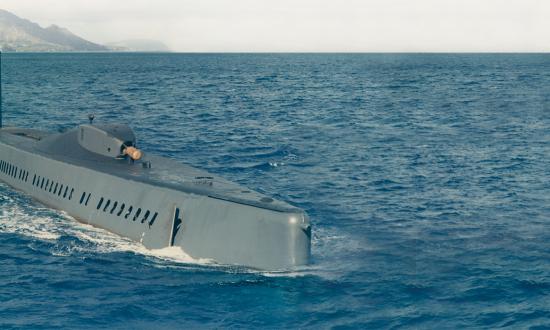Lieutenant (junior grade) Jake Marx, U.S. Coast Guard
Sailed right into a typhoon in the Gulf of Alaska on board a Coast Guard 378-footer in September 2019. We spent 20 hours in 35- to 45-foot seas with 50-foot swells. We had flooding in a few compartments and lost the ship’s bell.
Vice Admiral Robert F. Dunn, U.S. Navy (Retired)
On board the destroyer USS Nicholas (DDE-449) in a typhoon off Cheju Do, South Korea. As the winds increased and the seas got higher, the ship rolled to 42 degrees. Every duty resolved itself into hanging on. Nevertheless, all was well, until a petty officer paraded into the combat information center smoking a big black cigar!
Steven Palmer, Licensed Master Mariner, Life Member
During M/V APL Saipan’s voyage from Yokohama to Guam, we got caught in a storm 900 nm across with 30–50 knot winds. The engine was overheating in eight-meter seas and swell. At 0200 all non-bridge crew were sent to the engine control room while we turned to hove to. On a new heading of 310 at half ahead (9–10 knots), the vessel was going due south at 1.8 knots.
Commander Ken Pepper, U.S. Navy (Retired)
In autumn 1965, I was a radarman on the USS Ability (MSO-519) sailing from Charleston, South Carolina, to Newport, Rhode Island, in company with three other minesweepers when we were when overtaken by a strong hurricane. When in the trough of a wave, the crest would blank out the radar, 60 feet above the waterline.
Commander Bill McDonald, U.S. Navy (Retired)
On board the USS Biddle (DLG-34) in December 1969. While standing the midwatch, I flipped the radar to 60 miles and noticed an unexpected strong weather front approaching. It was a classic “perfect storm” and still regarded as one of the strongest storm surges ever on Hawaii’s North Shore. Fish were found on the O-5 level.
Rear Admiral Bob Wright, U.S. Navy (Retired)
In 1985, flying from the USS America (CV-66) headed to Vestfjorden, Norway. There were very low ceilings and high winds, with a wildly pitching deck. The entire flight was in the “goo” and only below 200 feet on approach could I see the deck. The deck was pitching so dramatically I could read the “66” up forward and then the carrier’s propellers out of the water.
Commander John M. McGrail, U.S. Navy (Retired)
In 1974, on board the USS Permit (SSN-594) running on the surface off Guam, a heavy roller pushed the bow into a down angle and forward motion drove the ship to periscope depth with an officer and lookout still on the bridge. The lookout had just detached his safety harness and would have been lost but for the officer who was still harnessed and able to grab him.
Captain Donald E. Pauly, U.S. Navy (Retired)
While commanding the USS Turner (DD-834) in 1968, we were plane guarding an aircraft carrier when caught in a Mediterranean hurricane. Nearing land ahead, both ships had to reverse course. I used left full rudder, starboard engine ahead flank, port back full, to turn quickly through the huge wave trough. We rolled 65 degrees. Close call!
Captain Jim Mottern, U.S. Naval reserve (Retired)
My destroyer, the USS Agerholm (DD-826), and its crew were almost lost in Typhoon Joan’s 80+ knot winds and 40+ foot seas in the South China Sea in October 1972. We were “slaves of the storm” for two days and almost broached several times, survived a 55-degree roll (the Agerholm capsize point was 50 degrees), and almost were wrecked on Woody Island in the Paracel Island chain. The commanding officer himself was surprised that the World War II–era destroyer survived. When it appeared that the ship might be doomed to be driven onto Woody Island, he planned to go to all-ahead flank to ram the ship up on Woody Island to save as many of the crew as possible. Years later, as I gained experience in my Navy career, I marveled at the fact that the Agerholm survived the storm. I believe the ship was saved by divine intervention.
Captain Rich Sloane, U.S. Navy (Retired), Golden Life Member
In the early 1970s, the weather was so bad the exercise, already at sea, was called off and we headed directly to Halifax, Nova Scotia. The frigate pounded and shuddered so violently, for the first time I thought it might break up. The natives were friendly.
Allan Voves
I was on a 400x125-foot pipe-laying barge on the North Sea off northern Scotland when we experienced a storm. Winds were 100mph with gusts to 125mph. Seas were 40 to 50 feet. We had 25 feet of freeboard and were taking 4 feet of green water down the deck. Down below in the hallways you could see lots of movement as the barge flexed. It lasted about six hours. All harbors were closed so we had to ride it out. It was awesome!
The USS Pittsburgh (CA-72) in a typhoon, June 1945. Naval Institute Photo Archive.
Captain O. Keith Evans, U.S. Navy (Retired)
I served for a year in Vietnam on 50-foot Swift boats. They rode like washing machines. Entering rivers during monsoon season was extremely dangerous; skilled helmsmen used rudders and engines to keep the boat’s stern to the sea to preclude broaching. Several sailors and boats were lost in this environment.
Lawrence Trevethan, U.S. Navy Veteran
In August 1966, the USS Francis Marion (APA-249) was in the 40-foot seas of Hurricane Faith in the western Atlantic. An electronic countermeasures set antenna had failed. It was so cold I could not feel the tiny screws! When I came down for safety reasons, my chief sent me back up, twice, insisting the set had to be working.
Ethan Harris
On board a 32-foot cutter trapped close inshore at the onset of a 55-knot (Beaufort force ten, whole gale) onshore wind. Took the offshore tack (port) and beat offshore under double reefed main and storm jib for 12 hours before achieving safe offing.
Alan L. Williams, U.S. Navy Veteran
In summer 1963, I was a Naval Reserve seaman assigned to the USS Laws (DD-558) on a cruise to Hawaii. A huge wave hit abeam and washed over the quarterdeck, where I was passing. It knocked me off my feet and carried me to the rail. Instinctively, I grabbed the lifeline.
Clark P. Thompson, U.S. Navy Veteran
On board the USS Koelsch (DE-1049) in December 1973 transiting to the Indian Ocean. As we navigated around the tip of Africa, we were running low on fuel. The oil embargo caused several countries to refuse to give us fuel. I remember reading the message board in the combat information center. It seemed bleak despite the efforts of Henry Kissinger. Then on a stormy night we came alongside a British merchant ship to refuel. I remember because I was on the midship high-line detail that night.
Keith Borelli, U.S. Navy Veteran
When I was an aviation ordnanceman on board the USS John F. Kennedy (CV-67), an armed A-7 attack aircraft taxied from elevator 2 to the bow catapults while I was securing a group of AIM-7 missiles to a transport skid. As the full power exhaust was just feet away, I held on for dear life to keep missiles from being blown down deck as a torpedo was slammed into the catwalk. But all was secured with only burned hand.
Lieutenant Commander Bob Alden, U.S. Navy (Retired)
In 1972, I was a junior officer on board the USS William V. Pratt (DLG-13) operating with the USS Franklin D. Roosevelt (CV-42) in the Bay of Biscay. The weather got so rough, the aircraft carrier took water over the bow and we lost our ship’s bell. Eating and sleeping were impossible.
Lieutenant Commander John Shaulis, U.S. Navy (Retired)
In January 1987, off the coast of Adak, Alaska. Flying Miss Piggy (a US-3A) servicing the USS Carl Vinson (CVN-70) in 50-knot winds, high seas, ice on the flight deck, and an F-14 over the scupper. The Carl Vinson needed its high priority parts and mail!
The USS George Phillip (FFG-12) in heavy seas. Naval Institute Photo Archive.
Jim Hammond, U.S. Navy Veteran
In spring 1964, while standing a modified bridge watch on board the USS Thornback (SS-418) with just the officer-of-the-deck (OOD), a rogue wave broke on the bridge and swept up through the shears. I was hanging on with two knuckles when the wave subsided. I looked down expecting the OOD to be gone. He was there and said in a matter-of-fact way, “Maybe it is time for a safety harness.”
Lieutenant Commander Steven Bannat, U.S. Navy (Retired)
Encountering a Gulf Stream rogue wave as a bridge watch stander on the USS Trippe (FF-1075) in early 1970s. The wave distorted the tightly dogged bridge windows to allow four inches of flooding of the enclosed bridge and wrenched the 5-inch 54 caliber gun barrel and all four cells of the antisubmarine rocket launcher perpendicular to the deck.
Chief Warrant Officer John Harris, U.S. Army Reserve (Retired), Life Member
On 27 Jan 1968, while underway in the after-torpedo room of the World War II–era diesel submarine USS Charr (AGSS-328), a sudden fire broke out in maneuvering. The electricians immediately vacated into our room, as everything went dark. I and the other 16-year old Naval Sea Cadet on board located the switches and restored emergency lighting. A review of escape procedures, just in case, were conducted, then OBAs put on. After ventilating, maneuvering was re-entered. I had quite a tale to tell my fellow 11th graders when I returned to High School on Monday.
Dr. Michael Zimmerman, U.S. Army Veteran
In 2001, while crossing the Drake Passage, the Caledonian Star was buried by a Southern Ocean 33-meter-high rogue wave, causing a 45-degree list, smashing the bridge windows and a wing, flooding the bridge, and washing away a lifeboat. A battery-operated SOS picked up in the Netherlands was relayed to Argentina, whose Navy guided us into Ushusia. I have built a model of the incident.



